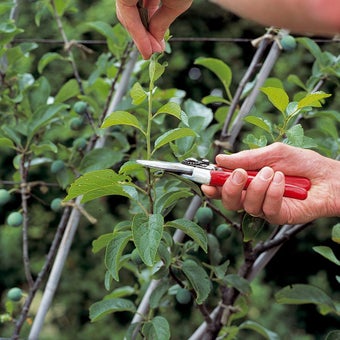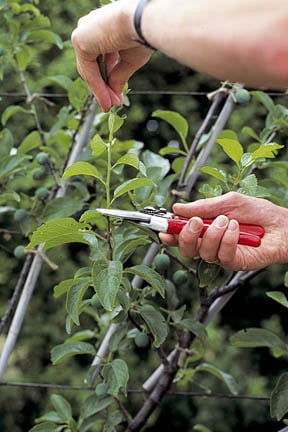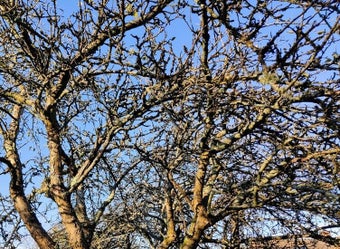
Quick facts
Suitable for - Apples and pears grown as bush or standard trees
Timing - November to early March
Difficulty - Easy
Suitable for...
Have you inherited an apple or pear in the garden but haven't a clue what to do with it? Or planted a fruit tree but been too scared to do any pruning? If yes, this page is for you.
When to prune
Prune your apple or pear tree in winter, when the leaves are off the tree.
An easy guide to pruning apples and pears
How to prune apple trees
Before getting started, remember;
- Take your time and stay safe - if you need to go up a ladder, consider investing in a special fruit tripod ladder that will let you get nice and close to the branches (great for picking fruit too)
- A sharp pair of secateurs and quality pruning saw can make all the difference
- Your tree will rarely look like the diagrams!
Five tips for pruning apples and pears
- How much do I prune off?
Aim to take between 10-20% of the overall canopy off in any one winter. Work around the tree evenly and keep an eye on your pruning pile - if it's looking a little big, STOP - you can always go back next year and do some more.
A little word of warning: The more you prune, the stronger the regrowth (if the tree is healthy). If you have pruned too hard, your tree is likely to produce vigorous upright branches called watershoots. This isn’t ideal as they crowd the crown. Watershoots growing in a convenient place – e.g. filling a gap – can be pruned by about third to encourage branching. Otherwise, remove watershoots from their point of origin. - What am I trying to achieve?
Your aim is to take out a bit of old wood each winter, to stimulate new. But the majority of the fruiting wood should be quite young - one to four years old, which is the wood that fruits best.
Also aim to create an open centre to your tree. This allows more light into the canopy to ripen the shoots and fruit. Improved air movement discourages diseases. - Avoid a 'hair cut'
Try to stagger your pruning cuts throughout the canopy. That way, the regrowth too will be even. If you only prune the top branches, this is where all the new growth will shoot up from, giving you a thicket of young, non-fruiting shoots that you'll just end up pruning off every year in exasperation (see gallery image). This will also reduce fruiting of tip and partial tip-bearing such as ‘Bramley’ and ‘Discovery’ as most of the fruiting wood will be removed.
Think of it as a thinning out process, selectively removing or shortening a branch here and there as you move around the tree. Focus on areas where the growth seems more crowded. - Avoid very big and very little pruning cuts
Even with very old trees, resist the temptation to prune off large limbs. These are at risk of decay. As a general rule, think twice before cutting into branches that are more than 10-12cm (4-5in) in diameter. If you must prune that branch, trace it away from the tree to see if there is a narrower section, perhaps where it forks and prune there instead. Avoid leaving a stub.
Equally, this is not about fiddly pruning. Most of your pruning cuts will be to branches that are between 1-5cm (½-2in). A fully pruned tree might only need 10-20 pruning cuts in total. - Should I use a pruning paint?
No, there is no need to use a pruning paint for cuts on apple or pear trees. However, these are sometimes used on plums, cherries and other members of the Prunus family as these are particularly susceptible to disease through pruning cuts.
If you're feeling more confident or think your tree is badly neglected and might need more drastic action, see our pages on winter pruning, winter regulated pruning and renovation of apples and pears.

Problems
Hopefully, if you stick to our five tips above, not too much will go wrong.
But getting up close and personal with your fruit tree might mean you spot other problems so here's what to do if you find;
- Grey/green crusty growths on the branches - this is lichen which is harmless to your tree and does not require any action
- Shrivelled, 'mummified' fruit clinging onto the shoots - these will have been infected with brown rot in the autumn and should be pruned out and binned or burned
- Dark, flaky, shrunken patches on some branches which may be dead beyond the patches - this is apple canker and affected shoots and branches are best cut out unless it is in a major limb or the main trunk
- Brown and shrivelled blossoms and die back of flowered shoot tips in late spring and early summer is caused by the disease blossom wilt
- A lot of dead branches with no apparent cause - this is a worrying sign as it may mean the tree has an underlying root problem such as honey fungus. If the dieback continues you may want to get it looked at by a professional arborist
- Cavities in the main trunk or branches - old apple and pears trees can develop natural cavities that sometimes fill with water. This is not necessarily a problem and may be quite stable (i.e. not get worse or cause the tree to be unsafe). Do not drill into trees to drain water from cavities as this could allow disease to enter. If the cavity is getting noticeably larger, the tree looks in poor health and/or a bracket fungus appears on the stem, it is time to seek professional advice from an arborist









